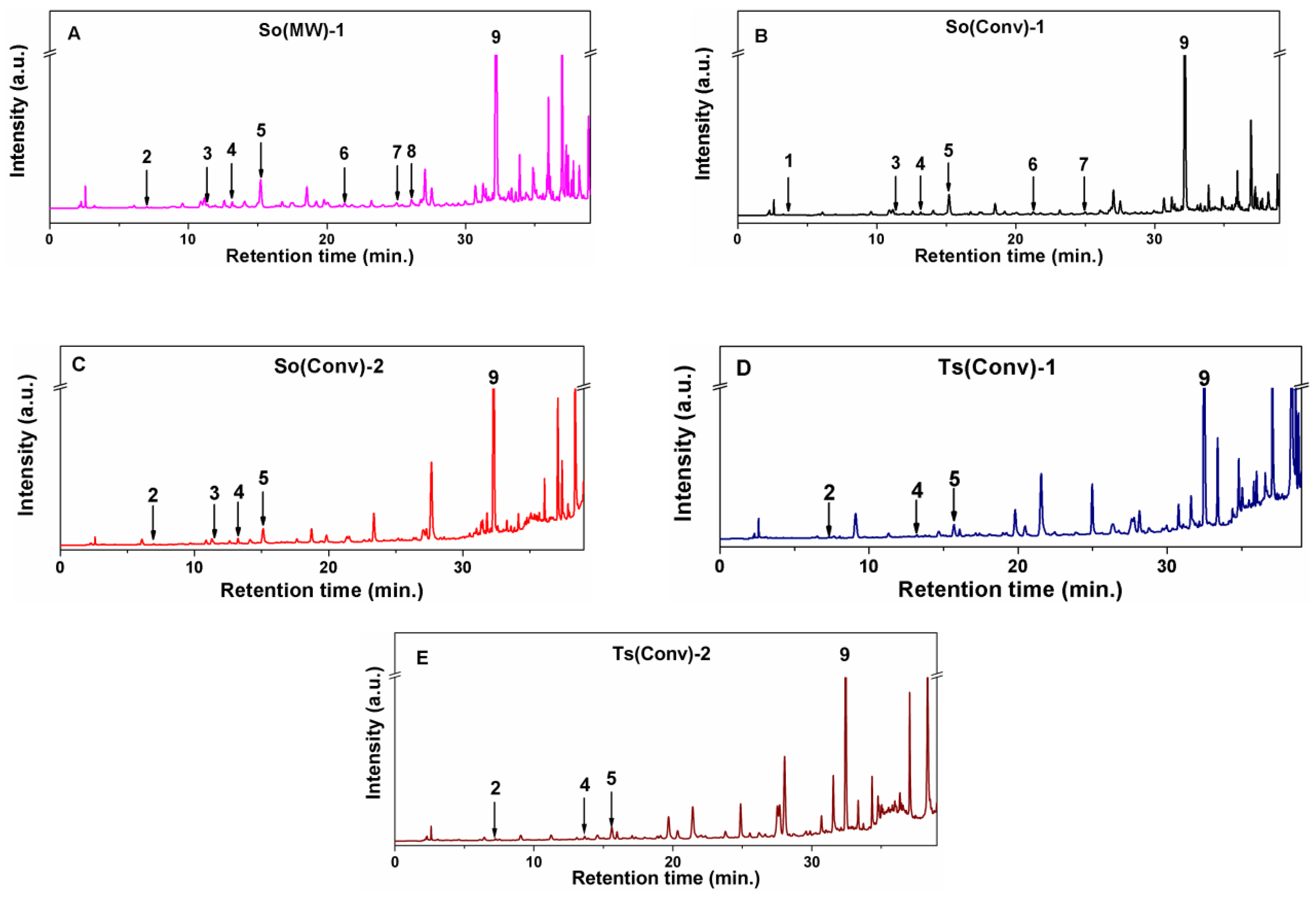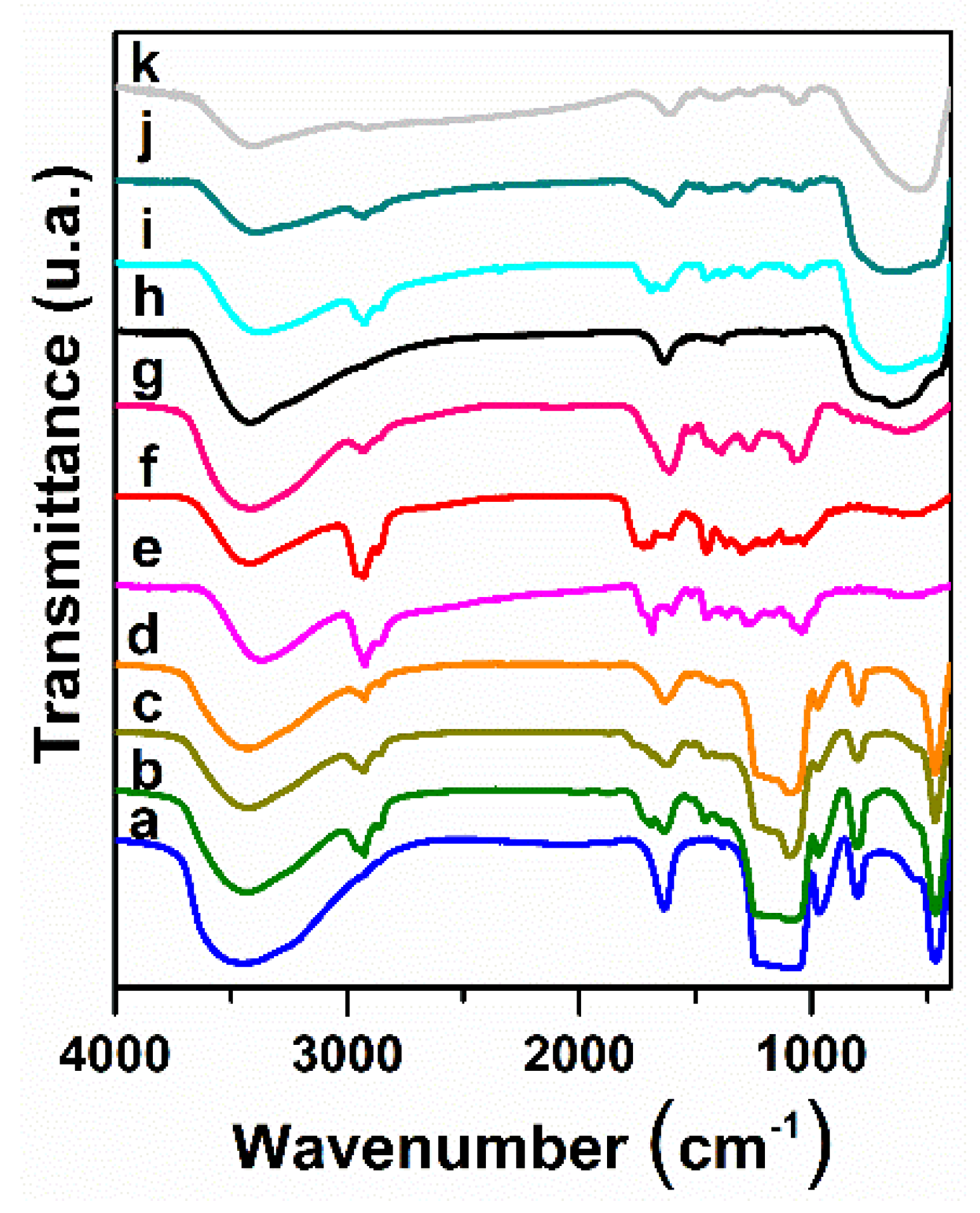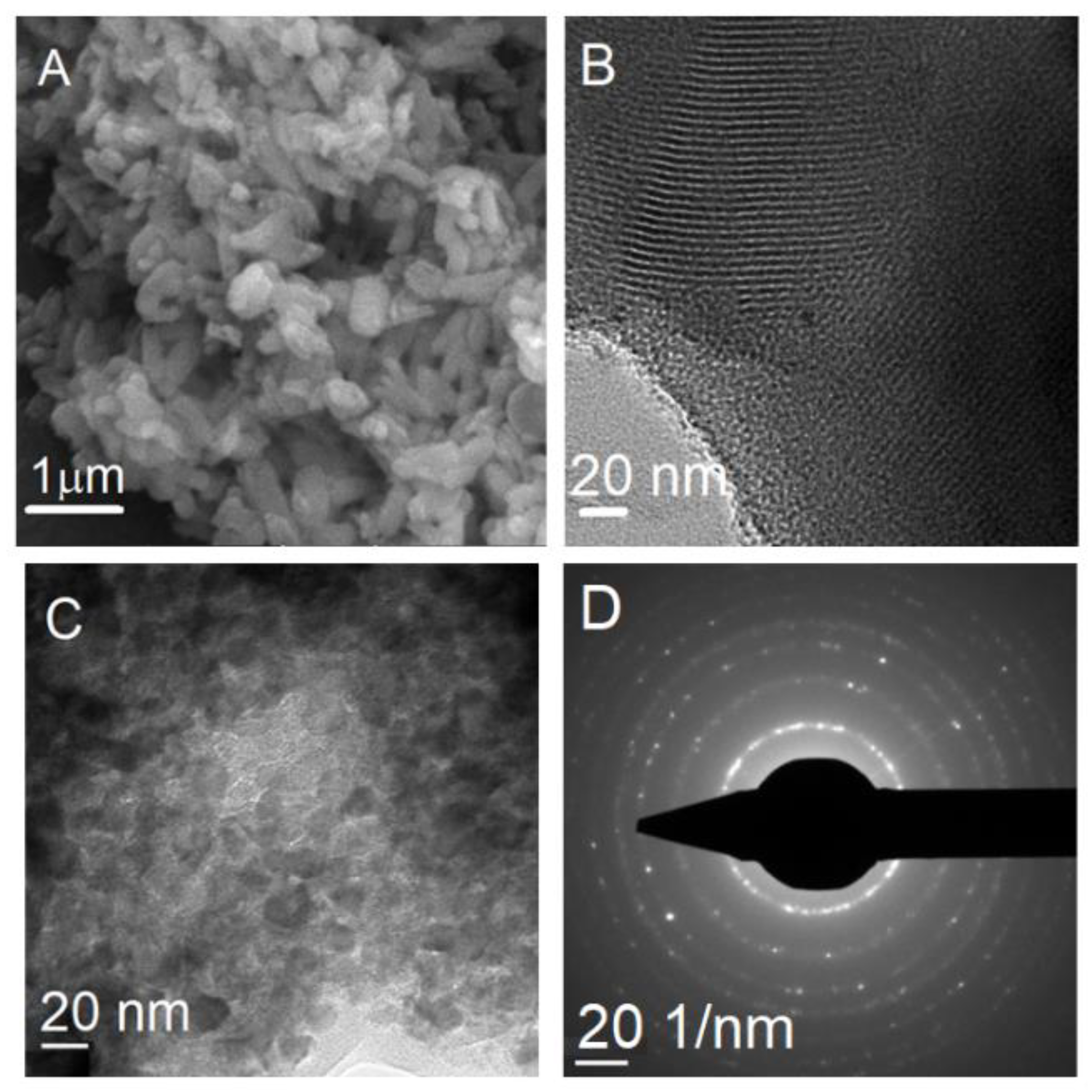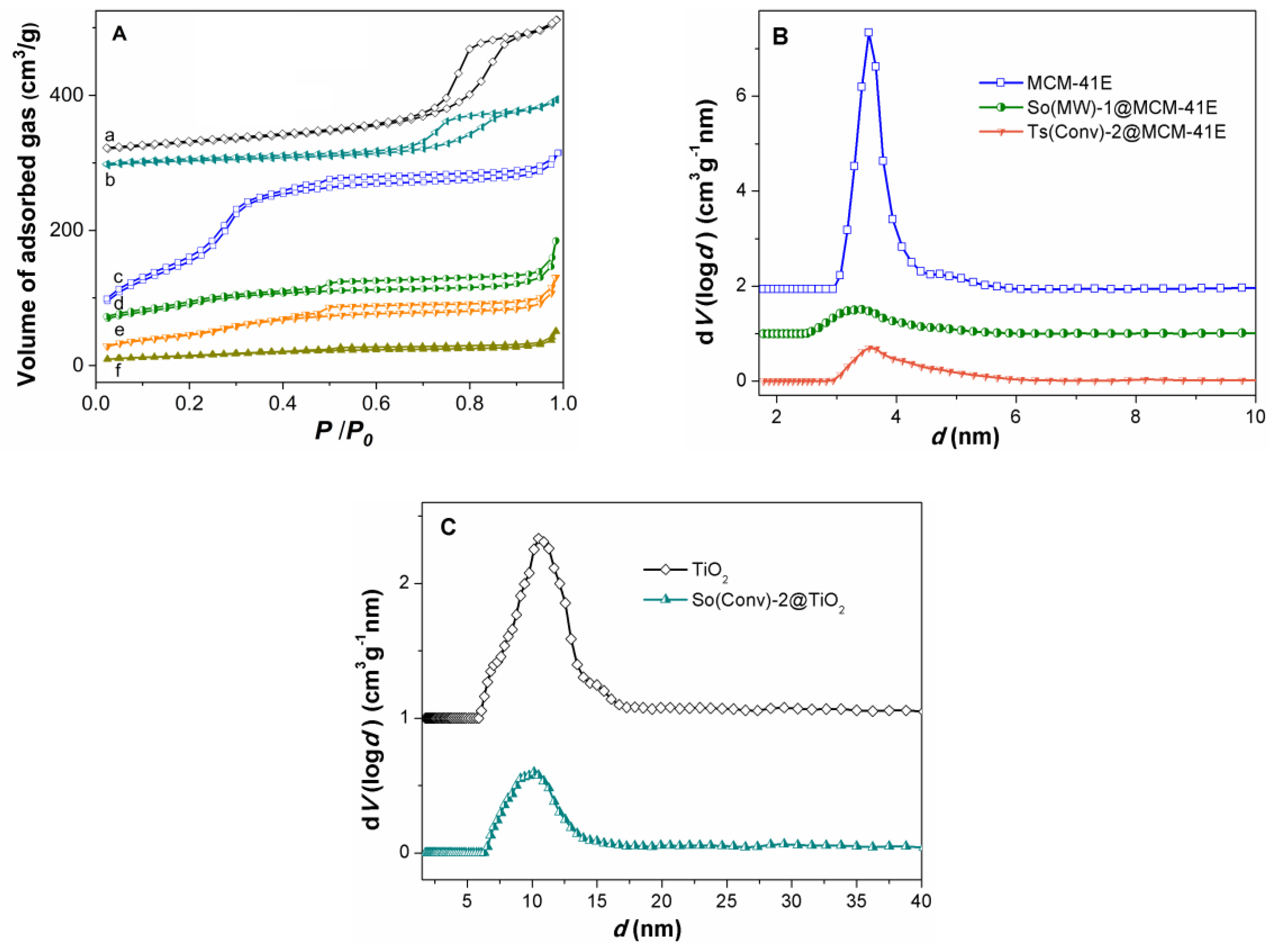Properties of Salvia officinalis L. and Thymus serpyllum L. Extracts Free and Embedded into Mesopores of Silica and Titania Nanomaterials
Abstract
1. Introduction
2. Materials and Methods
2.1. Materials
2.2. Preparation of Phenolic Extracts from Salvia officinalis and Thymus serpyllum
2.3. Characterization of Polyphenolic Extracts
2.4. Obtaining of Mesoporous Inorganic Matrices
2.5. Embedding of Phenolic Extracts into Mesoporous Inorganic Supports
2.6. Characterization of Supports and Materials Containing Extract
2.7. Determination of Radical Scavenging Activity
2.8. Assessment of Antimicrobial activity
2.8.1. Method of Disk Diffusion
2.8.2. Determination of Minimum Inhibitory Concentration (MIC) and Minimum Bactericidal Concentration (MBC)
2.8.3. Antimicrobial Activity of Materials Containing Extract by the Disk Diffusion Method
3. Results and Discussion
3.1. Characterisation of Polyphenolic Extracts by Spectrometric Determinations
3.2. Chemical Profile of Common Sage and Wild Thyme Extracts
3.3. Radical Scavenger Activity of Polyphenolic Extracts
3.4. Antimicrobial Activity of Polyphenolic Extracts
3.5. Characterisation of Mesoporous Supports
3.6. Characterization of Materials Containing Extract
3.7. Recovery of Components from Materials Containing Extract
3.8. Radical Scavenging Capacity of Materials Containing Extract
3.9. Antimicrobial Properties of Materials Containing Extract
4. Conclusions
Supplementary Materials
Author Contributions
Funding
Acknowledgments
Conflicts of Interest
References
- Tohma, H.; Köksal, E.; Kilic, Ö.; Alan, Y.; Yilmaz, M.; Gulcin, I.; Bursal, E.; Harrath, A.H. RP-HPLC/MS/MS analysis of the phenolic compounds, antioxidant and antimicrobial activities of Salvia L. species. Antioxidants 2016, 5, 38. [Google Scholar] [CrossRef]
- Păvăloiu, R.-D.; Sha’At, F.; Bubueanu, C.; Deaconu, M.; Neagu, G.; Sha’At, M.; Anastasescu, M.; Mihailescu, M.; Matei, C.; Nechifor, G.; et al. Polyphenolic extract from Sambucus ebulus L. leaves free and loaded into lipid vesicles. Nanomaterials 2020, 10, 56. [Google Scholar] [CrossRef] [PubMed]
- Danciu, C.; Muntean, D.; Alexa, E.; Farcas, C.; Oprean, C.; Zupkó, I.; Bor, A.; Minda, D.; Proks, M.; Buda, V.; et al. Phytochemical characterization and evaluation of the antimicrobial, antiproliferative and pro-apoptotic potential of Ephedra alata Decne. hydroalcoholic extract against the MCF-7 breast cancer cell line. Molecules 2019, 24, 13. [Google Scholar] [CrossRef] [PubMed]
- Rayan, M.; Abu-Farich, B.; Basha, W.; Rayan, A.; Abu-Lafi, S. Correlation between antibacterial activity and free-radical scavenging: In-vitro evaluation of polar/non-polar extracts from 25 plants. Processes 2020, 8, 117. [Google Scholar] [CrossRef]
- Afonso, A.F.; Pereira, O.R.; Fernandes, Â.; Calhelha, R.C.; Silva, A.; Ferreira, I.C.F.R.; Cardoso, S. Phytochemical composition and bioactive effects of Salvia africana, Salvia officinalis ’Icterina’ and Salvia mexicana aqueous extracts. Molecules 2019, 24, 4327. [Google Scholar] [CrossRef]
- Jiang, Y.; Zhang, L.; Rupasinghe, H.P.V. Antiproliferative effects of extracts from Salvia officinalis L. and Saliva miltiorrhiza Bunge on hepatocellular carcinoma cells. Biomed. Pharmacother. 2017, 85, 57–67. [Google Scholar] [CrossRef] [PubMed]
- Pop, A.; Muste, S.; Mureșan, C.; Pop, C.; Salanță, L. Comparative study regarding the importance of sage (salvia officinalis l.) in terms of antioxidant capacity and antimicrobial activities. Hop Med. Plants 2013, 2, 66–74. [Google Scholar]
- Jasicka-Misiak, I.; Poliwoda, A.; Petecka, M.; Buslovych, O.; Shlyapnikov, V.A.; Wieczorek, P.P. Antioxidant phenolic compounds in Salvia officinalis L. and Salvia sclarea L. Ecol. Chem. Eng. S 2018, 25, 133–142. [Google Scholar] [CrossRef]
- Velickovic, D.; Karabegovic, I.; Stojicevic, S.; Lazić, M.; Marinkovic, V.; Veljković, V.B. Comparison of antioxidant and antimicrobial activities of extracts obtained from Salvia glutinosa L. and Salvia officinalis L. Chem. Ind. 2011, 65, 599–605. [Google Scholar] [CrossRef][Green Version]
- Armini, L.; Mojab, F.; Jahanfar, S.; Sepidarkish, M.; Raoofi, Z.; Maleki-Hajiagha, A. Efficacy of Salvia officinalis extract on the prevention of insulin resistance in euglycemic patients with polycystic ovary syndrome: A double-blinded placebo-controlled clinical trial. Complement. Ther. Med. 2020, 48, 102245. [Google Scholar] [CrossRef]
- Perry, N.S.L.; Bollen, C.; Perry, E.; Ballard, C. Salvia for dementia therapy: Review of pharmacological activity and pilot tolerability clinical trial. Pharmacol. Biochem. Behav. 2003, 75, 651–659. [Google Scholar] [CrossRef]
- Firuzi, O.; Miri, R.; Asadollahi, M.; Eslami, S.; Jassbi, A.R. Cytotoxic, Antioxidant and antimicrobial activities and phenolic contents of Eleven Salvia species from Iran. Iran. J. Pharm. Res. 2013, 12, 801–810. [Google Scholar] [PubMed]
- Cegiełka, A.; Hać-Szymańczuk, E.; Piwowarek, K.; Dasiewicz, K.; Słowiński, M.; Wrońska, K. The use of bioactive properties of sage preparations to improve the storage stability of low-pressure mechanically separated meat from chickens. Poult. Sci. 2019, 98, 5045–5053. [Google Scholar] [CrossRef] [PubMed]
- Jovanovic, A.A.; Ðordevic, V.B.; Zdunic, G.M.; Pljevljakušic, D.S.; Šavikin, K.P.; Godevac, D.M.; Bugarski, B.M. Optimization of the extraction process of polyphenols from Thymus serpyllum L. herb using maceration, heat-and ultrasound-assisted techniques. Sep. Purif. Technol. 2017, 179, 369–380. [Google Scholar] [CrossRef]
- Berdowska, I.; Zielinski, B.; Fecka, I.; Kulbacka, J.; Saczko, J.; Gamian, A. Cytotoxic impact of phenolics from Lamiaceae species on human breast cancer cells. Food Chem. 2013, 141, 1313–1321. [Google Scholar] [CrossRef] [PubMed]
- Nutrizio, M.; Kljusurić, J.G.; Sabolović, M.B.; Kovačević, D.B.; Šupljika, F.; Putnik, P.; Čakić, M.S.; Dubrović, I.; Vrsaljko, D.; Maltar-Strmečki, N.; et al. Valorization of sage extracts (Salvia officinalis L.) obtained by high voltage electrical discharges: Process control and antioxidant properties. Innov. Food Sci. Emerg. Technol. 2020, 60, 102284. [Google Scholar] [CrossRef]
- Nicolai, M.; Pereira, P.; Vitor, R.F.; Reis, C.; Roberto, A.; Rijo, P. Antioxidant activity and rosmarinic acid content of ultrasound-assisted ethanolic extracts of medicinal plants. Measurement 2016, 89, 328–332. [Google Scholar] [CrossRef]
- Durling, N.; Catchpole, O.; Grey, J.; Webby, R.; Mitchell, K.; Foo, L.; Perry, N.B. Extraction of phenolics and essential oil from dried sage (Salvia officinalis) using ethanol–water mixtures. Food Chem. 2007, 101, 1417–1424. [Google Scholar] [CrossRef]
- Maini, S.; Hodgson, H.L.; Krol, E. The UVA and aqueous stability of flavonoids is dependent on B-ring substitution. J. Agric. Food Chem. 2012, 60, 6966–6976. [Google Scholar] [CrossRef]
- Deng, J.; Yang, H.; Çapanoğlu, E.; Cao, H.; Xiao, J. Technological aspects and stability of polyphenols. In Polyphenols: Properties, Recovery, and Applications, 1st ed.; Galankis, C., Ed.; Elsevier: Amsterdam, The Netherlands, 2018; pp. 295–323. [Google Scholar]
- Khan, M.A.; Wallace, W.T.; Islam, S.; Nagpure, S.; Strzalka, J.; Littleton, J.M.; Rankin, S.E.; Knutson, B.L. Adsorption and recovery of polyphenolic flavonoids using TiO2-functionalized mesoporous silica nanoparticles. ACS Appl. Mater. Interfaces 2017, 9, 32114–32125. [Google Scholar] [CrossRef]
- Medically reviewed by Drugs.com, Silicon Dioxide Colloidal (inactive ingredient)–Drug.com. Available online: https://www.drugs.com/inactive/silicon-dioxide-colloidal-200.html. (accessed on 25 March 2020).
- Rowe, R.C.; Sheskey, P.J.; Weller, P.J. Handbook of Pharmaceutical Excipients, 4th ed.; Libros Digitales-Pharmaceutical Press: London, UK; American Pharmaceutical Association: Washington, DC, USA, 2003. [Google Scholar]
- Doadrio, J.C.; Salinas, A.; Sánchez-Montero, J.; Vallet-Regí, M. Drug release from ordered mesoporous silicas. Curr. Pharm. Des. 2015, 21, 6213–6819. [Google Scholar] [CrossRef] [PubMed]
- Rajagopal, G.; Maruthamuthu, S.; Mohanan, S.; Palaniswamy, N. Biocidal effects of photocatalytic semiconductor TiO2. Colloids Surfaces B: Biointerfaces 2006, 51, 107–111. [Google Scholar] [CrossRef] [PubMed]
- Chorianopoulos, N.; Tsoukleris, D.; Panagou, E.; Falaras, P.; Nychas, G.-J.E. Use of titanium dioxide (TiO2) photocatalysts as alternative means for Listeria monocytogenes biofilm disinfection in food processing. Food Microbiol. 2011, 28, 164–170. [Google Scholar] [CrossRef] [PubMed]
- Özyildiz, F.; Uzel, A.; Hazar, A.S.; Guden, M.; Ölmez, S.; Aras, I.; Karaboz, I. Photocatalytic antimicrobial effect of TiO2 anatase thin-film–coated orthodontic arch wires on 3 oral pathogens. Turk. J. Boil. 2014, 38, 289–295. [Google Scholar] [CrossRef]
- Pezzoni, M.; Catalano, P.N.; Delgado, D.C.; Pizarro, R.A.; Bellino, M.G.; Costa, C.S. Antibiofilm effect of mesoporous titania coatings on Pseudomonas aeruginosa biofilms. J. Photochem. Photobiol. B: Boil. 2019, 203, 111762. [Google Scholar] [CrossRef]
- Brezoiu, A.-M.; Matei, C.; Deaconu, M.; Stanciuc, A.-M.; Trifan, A.; Gaspar-Pintiliescu, A.; Berger, D. Polyphenols extract from grape pomace. Characterization and valorization through encapsulation into mesoporous silica-type matrices. Food Chem. Toxicol. 2019, 133, 110787. [Google Scholar] [CrossRef]
- Caesar, J.; Tamm, A.; Ruckteschler, N.; Weber, B. Revisiting chlorophyll extraction methods in biological soil crusts – methodology for determination of chlorophyll a and chlorophyll a+b as compared to previous methods. Biogeosciences 2018, 15, 1415. [Google Scholar] [CrossRef]
- Brezoiu, A.-M.; Deaconu, M.; Nicu, I.; Vasile, E.; Mitran, R.-A.; Matei, C.; Berger, D. Heteroatom modified MCM-41-silica carriers for Lomefloxacin delivery systems. Microporous Mesoporous Mater. 2019, 275, 214–222. [Google Scholar] [CrossRef]
- Muntean, D.; Licker, M.; Alexa, E.; Popescu, I.; Jianu, C.; Buda, V.; Dehelean, C.A.; Ghiulai, R.; Horhat, F.G.; Horhat, D.; et al. Evaluation of essential oil obtained from Mentha piperita L. against multidrug-resistant strains. Infect. Drug Resist. 2019, 12, 2905–2914. [Google Scholar] [CrossRef]
- Patel, J.B.; Cockerill, F.R.; Bradford, P.A. Performance Standards for Antimicrobial Susceptibility Testing; Twenty-Fifth Informational Supplement. CLSI document M100-S25; Clinical and Laboratory Standards Institute: Wayne, PA, USA, 2015; Volume 35, pp. 54, 66, 86, 99. [Google Scholar]
- Deaconu, M.; Pintilie, L.; Vasile, E.; Mitran, R.-A.; Pircalabioru, G.G.; Matei, C.; Chifiriuc, M.C.; Berger, D. Norfloxacin delivery systems based on MCM-type silica carriers designed for the treatment of severe infections. Mater. Chem. Phys. 2019, 238, 121886. [Google Scholar] [CrossRef]
- Nkhili, E.; Tomao, V.; El Hajji, H.; Chemat, F.; Dangles, O.; El Boustani, E.-S. Microwave-assisted water extraction of green tea polyphenols. Phytochem. Anal. 2009, 20, 408–415. [Google Scholar] [CrossRef] [PubMed]
- Gallo, M.; Ferracane, R.; Graziani, G.; Ritieni, A.; Fogliano, V. Microwave assisted extraction of phenolic compounds from four different spices. Molecules 2010, 15, 6365–6374. [Google Scholar] [CrossRef] [PubMed]
- Jovanovic, A.; Petrović, P.; Ðordjevic, V.; Zdunić, G.; Šavikin, K.; Bugarski, B. Polyphenols extraction from plant sources. Lek. sirovine 2017, 37, 45–49. [Google Scholar] [CrossRef]
- Lee, C.-J.; Chen, L.-G.; Chang, T.-L.; Ke, W.-M.; Lo, Y.-F.; Wang, C.-C. The correlation between skin-care effects and phytochemical contents in Lamiaceae plants. Food Chem. 2011, 124, 833–841. [Google Scholar] [CrossRef]
- Atanassova, M.; Georgieva, S.; Ivancheva, K. Total phenolic and total flavonoid contents, antioxidant capacity and biological contaminants in medicinal herbs. Chem. Technol. Metall. 2011, 46, 81–88. [Google Scholar]
- Stanciu, G.; Cristache, N.; Lupsor, S.; Dobrinas, S. Evaluation of antioxidant activity and total phenols content in selected spices. Rev. Chim. 2017, 68, 1429–1434. [Google Scholar] [CrossRef]
- Miron, T.; Plaza, M.; Bahrim, G.; Ibanez, E.; Herrero, M. Chemical composition of bioactive pressurized extracts of Romanian aromatic plants. J. Chromatogr. A 2011, 1218, 4918–4927. [Google Scholar] [CrossRef]
- Pasca, C.; Mărghitaș, L.A.; Bobis, O.; Dezmirean, D.S.; Mărgăoan, R.; Mureșan, C.I. Total Content of Polyphenols and Antioxidant Activity of Different Melliferous Plants. Bull. Univ. Agric. Sci. Veter- Med. Cluj-Napoca. Anim. Sci. Biotechnol. 2016, 73, 1–9. [Google Scholar] [CrossRef]
- Abramovic, H.; Abram, V.; Cuk, A.; Ceh, B.; Smole Mozina, S.; Vidmar, M.; Pavlovic, M.; Poklar Ulrih, N. Antioxidative and antibacterial properties of organically grown thyme (Thymus sp.) and basil (Ocimum basilicum L.). Turk. J. Agric. For. 2018, 42, 185–194. [Google Scholar] [CrossRef]
- Oniga, I.; Vlase, L.; Hanganu, D.; Toiu, A.; Benedec, D. Comparative assessment of phenolic profile and antioxidant activity of some indigenous Salvia species. Hop Med. Plants 2018, 26, 76–83. [Google Scholar]
- Duletic-Lausevic, S.; Alimpic, A.; Pavlovic, D.; Marin, P.D.; Lakusic, D. Salvia officinalis of different origins. Antioxidant activity, phenolic and flavonoid content of extracts. Agro. Food Ind. Hi. Tech. 2016, 27, 52–55. [Google Scholar]
- Amamra, S. Determination of total phenolics contents, antioxidant capacity of Thymus vulgaris extracts using electrochemical and spectrophotometric methods. Int. J. Electrochem. Sci. 2018, 13, 7882–7893. [Google Scholar] [CrossRef]
- Sumanta, N.; Haque, C.I.; Nishika, J.; Suprakash, R. Spectrophotometric analysis of chlorophylls and carotenoids from commonly grown fern species by using various extracting solvents. Res. J. Chem. Sci. 2014, 4, 63–69. [Google Scholar]
- Žilić, S.; Janković, M.; Basić, Z.; Vančetović, J.; Maksimović, V.M. Antioxidant activity, phenolic profile, chlorophyll and mineral matter content of corn silk (Zea mays L): Comparison with medicinal herbs. J. Cereal Sci. 2016, 69, 363–370. [Google Scholar] [CrossRef]
- Kozics, K.; Klusová, V.; Srancikova, A.; Mučaji, P.; Slameňová, D.; Hunakova, L.; Kusznierewicz, B.; Horváthová, E. Effects of Salvia officinalis and Thymus vulgaris on oxidant-induced DNA damage and antioxidant status in HepG2 cells. Food Chem. 2013, 141, 2198–2206. [Google Scholar] [CrossRef]
- Ben Farhat, M.; Chaouch-Hamada, R.; Sotomayor, J.A.; Landoulsi, A.; Jordán, M.J. Antioxidant potential of Salvia officinalis L. residues as affected by the harvesting time. Ind. Crop. Prod. 2014, 54, 78–85. [Google Scholar] [CrossRef]
- Sonmezdag, A.S.; Kelebek, H.; Selli, S. Characterization of aroma-active and phenolic profiles of wild thyme (Thymus serpyllum) by GC-MS-Olfactometry and LC-ESI-MS/MS. J. Food Sci. Technol. 2015, 53, 1957–1965. [Google Scholar] [CrossRef]
- Fernandes, R.; Trindade, M.; Tonin, F.; De Lima, C.G.; Pugine, S.M.P.; Munekata, P.E.S.; Lorenzo, J.M.; De Melo, M.P. Evaluation of antioxidant capacity of 13 plant extracts by three different methods: Cluster analyses applied for selection of the natural extracts with higher antioxidant capacity to replace synthetic antioxidant in lamb burgers. J. Food Sci. Technol. 2015, 53, 451–460. [Google Scholar] [CrossRef]
- Ghedini, E.; Nichele, V.; Signoretto, M.; Cerrato, G. Structure-Directing Agents for the Synthesis of TiO2-Based Drug-Delivery Systems. Chem.-A Eur. J. 2012, 18, 10653–10660. [Google Scholar] [CrossRef]







| Extract | Extract (wt %) | TPC (mgCAE/ge) | TPC (mgGAE/ge) | RSADPPH (mgTE/ge) | RSAABTS (mgTE/ge) | TFC (mgRE/ge) | Ch-a (mgCh-a/ge) | Ch-b (mgCh-b/ge) |
|---|---|---|---|---|---|---|---|---|
| So(MW)-1 | 25.70 | 107.45 ± 3.53 | 119.85 ± 3.94 | 236.43 ± 1.77 | 232.79 ± 8.23 | 75.52 ± 0.70 | 3.95 ± 0.46 | 0.97 ± 0.11 |
| So(Conv)-1 | 18.89 | 97.68 ± 1.53 | 108.95 ± 1.70 | 180.81 ± 5.75 | 96.81 ± 3.63 | 70.17 ± 0.37 | 3.12 ± 0.03 | 0.57 ± 0.02 |
| So(Conv)-2 | 34.19 | 164.54 ± 3.71 | 181.11 ± 4.07 | 215.74 ± 13.72 | 169.99 ± 5.52 | 40.92 ± 1.02 | 0.64 ± 0.02 | 0.29 ± 0.03 |
| Ts(Conv)-1 | 11.77 | 140.51 ± 4.32 | 154.67 ± 4.75 | 161.61 ± 15.58 | 74.44 ± 0.92 | 83.10 ± 1.85 | 5.25 ± 0.00 | 0.91 ± 0.03 |
| Ts(Conv)-2 | 14.28 | 141.24 ± 3.26 | 155.50 ± 3.61 | 185.89 ± 2.76 | 105.63 ± 4.56 | 81.28 ± 2.03 | 1.05 ± 0.04 | 0.28 ± 0.02 |
| Concentration in Extract (mg/g extract) | ||||||
|---|---|---|---|---|---|---|
| Standard Compound | RT (min) | So(MW)-1 | So(Conv)-1 | So(Conv)-2 | Ts(Conv)-1 | Ts(Conv)-2 |
| gallic acid | 3.605 | nd | 0.028 ± 0.000 | nd | nd | nd |
| protocatechuic acid | 6.982 | 0.069 ± 0.000 | nd | 0.200 ± 0.001 | 0.183 ± 0.001 | 0.354 ± 0.023 |
| caftaric acid | 11.376 | 0.426 ± 0.001 | 0.360 ± 0.001 | 0.821 ± 0.002 | nd | nd |
| chlorogenic acid | 13.016 | 0.286 ± 0.000 | 0.340 ± 0.002 | 0.870 ± 0.000 | 0.320 ± 0.001 | 0.775 ± 0.009 |
| caffeic acid | 15.075 | 0.813 ± 0.001 | 1.505 ± 0.010 | 1.623 ± 0.006 | 1.043 ± 0.008 | 1.553 ± 0.022 |
| trans p-coumaric acid | 21.674 | 0.060 ± 0.001 | 0.102 ± 0.000 | nd | nd | nd |
| trans ferulic acid | 25.027 | 0.134 ± 0.000 | 0.180 ± 0.002 | nd | nd | nd |
| rutin hydrate | 25.964 | 0.604 ± 0.000 | nd | nd | nd | nd |
| rosmarinic acid | 32.139 | 25.712 ± 0.014 | 41.600 ± 0.253 | 49.582 ± 0.034 | 41.975 ± 0.028 | 39.004 ± 0.125 |
| Sample | IC50% (mg/mL) | Correlation equation | R2 |
|---|---|---|---|
| So(MW)-1 | 1.15 | y = 43.321x + 0.326 | 0.9940 |
| So(Conv)-1 | 1.50 | y = 31.526x + 2.731 | 0.9974 |
| So(Conv)-2 | 1.26 | y = 34.660x + 6.447 | 0.9970 |
| Ts(Conv)-1 | 1.68 | y = 25.890x + 6.569 | 0.9980 |
| Ts(Conv)-2 | 1.46 | y = 30.116x + 6.079 | 0.9910 |
| Caffeic acid | 0.20 | y = 239.815x + 3.130 | 0.9999 |
| Rosmarinic acid | 0.13 | y = 383.122x + 1.780 | 0.9996 |
| Strain Species | ΦSo(MW) (30 mg/mL) | MIC/MBC (mg/mL) | ΦSo(conv)-2 (20 mg/mL) | MIC/MBC (mg/mL) | ΦTs(conv)-2 (28.5 mg/mL) | MIC/MBC (mg/mL) |
|---|---|---|---|---|---|---|
| Salmonella enterica serotip typhimurium | 17 | 7.5/15 | 10 | - | 9 | - |
| Shigella flexneri serotype 2b | 16 | 7.5/15 | 10 | - | 9 | - |
| Enterococcus faecalis | 18 | 7.5/7.5 | 18 | 10.125/10.125 | 10 | - |
| Escherichia coli | 17 | 7.5/7.5 | 18 | 10.125/10.125 | 10 | - |
| Pseudomonas aeruginosa | 17 | 7.5/15 | 11 | - | 10 | - |
| Staphylococcus aureus | 19 | 3.75/7.5 | 19 | 5.06/10.125 | 11 | - |
| Streptococcus pneumoniae | 20 | 3.75/7.5 | 19 | 5.06/10.125 | 15 | 14.25/28.5 |
| Streptococcus pyogenes | 22 | 3.75/7.5 | 20 | 5.06/10.125 | 17 | 14.25/28.5 |
| Bacteroides fragillis | 17 | 7.5/7.5 | 18 | 10.125/10.125 | 9 | - |
| Support | d (nm) | SBET (m2/g) | Vp (cm3/g) | Embedded Extract | Extract (wt %) | d (nm) | Vp (cm3/g) |
|---|---|---|---|---|---|---|---|
| TiO2 | 10.49 | 115 | 0.34 | So(MW)-1@TiO2 | 29 | - | - |
| So(Conv)-2@TiO2 | 22 | 10.13 | 0.16 | ||||
| Ts(Conv)-2@TiO2 | 20 | - | - | ||||
| MCM-41E | 3.54 | 689 | 0.54 | So(MW)-1@MCM-41E | 22 | 3.42 | 0.20 |
| So(Conv)-2@MCM-41E | 44 | - | 0.08 | ||||
| Ts(Conv)-2@MCM-41E | 22 | 3.54 | 0.18 |
| Species Strains | Φ (mm) |
|---|---|
| Salmonella enterica | 11 |
| Shigella flexneri serotype 2b | 11 |
| Enterococcus faecalis | 23 |
| Escherichia coli | 21 |
| Pseudomonas aeruginosa | 14 |
| Staphylococcus aureus | 23 |
| Streptococcus pneumoniae | 23 |
| Streptococcus pyogenes | 23 |
| Bacteroides fragillis | 21 |
| Candida albicans | 9 |
| Candida parapsilosis | 9 |
© 2020 by the authors. Licensee MDPI, Basel, Switzerland. This article is an open access article distributed under the terms and conditions of the Creative Commons Attribution (CC BY) license (http://creativecommons.org/licenses/by/4.0/).
Share and Cite
Brezoiu, A.-M.; Prundeanu, M.; Berger, D.; Deaconu, M.; Matei, C.; Oprea, O.; Vasile, E.; Negreanu-Pîrjol, T.; Muntean, D.; Danciu, C. Properties of Salvia officinalis L. and Thymus serpyllum L. Extracts Free and Embedded into Mesopores of Silica and Titania Nanomaterials. Nanomaterials 2020, 10, 820. https://doi.org/10.3390/nano10050820
Brezoiu A-M, Prundeanu M, Berger D, Deaconu M, Matei C, Oprea O, Vasile E, Negreanu-Pîrjol T, Muntean D, Danciu C. Properties of Salvia officinalis L. and Thymus serpyllum L. Extracts Free and Embedded into Mesopores of Silica and Titania Nanomaterials. Nanomaterials. 2020; 10(5):820. https://doi.org/10.3390/nano10050820
Chicago/Turabian StyleBrezoiu, Ana-Maria, Mioara Prundeanu, Daniela Berger, Mihaela Deaconu, Cristian Matei, Ovidiu Oprea, Eugeniu Vasile, Ticuța Negreanu-Pîrjol, Delia Muntean, and Corina Danciu. 2020. "Properties of Salvia officinalis L. and Thymus serpyllum L. Extracts Free and Embedded into Mesopores of Silica and Titania Nanomaterials" Nanomaterials 10, no. 5: 820. https://doi.org/10.3390/nano10050820
APA StyleBrezoiu, A.-M., Prundeanu, M., Berger, D., Deaconu, M., Matei, C., Oprea, O., Vasile, E., Negreanu-Pîrjol, T., Muntean, D., & Danciu, C. (2020). Properties of Salvia officinalis L. and Thymus serpyllum L. Extracts Free and Embedded into Mesopores of Silica and Titania Nanomaterials. Nanomaterials, 10(5), 820. https://doi.org/10.3390/nano10050820













